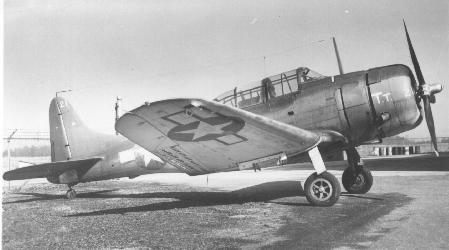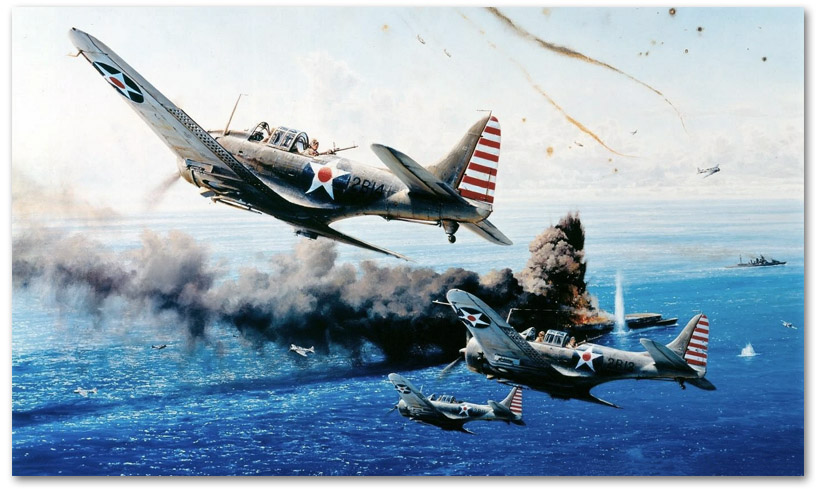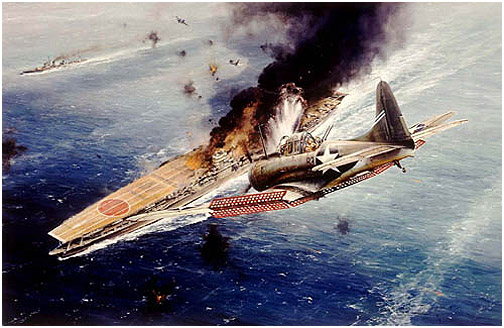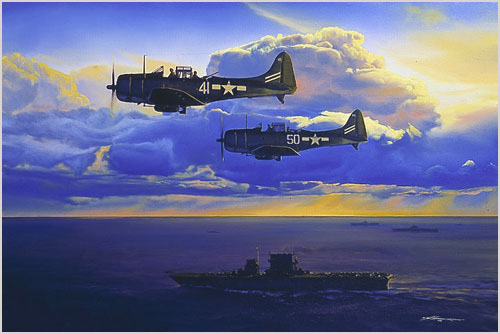|
Posted on 09/25/2003 12:00:07 AM PDT by SAMWolf
|
|
 are acknowledged, affirmed and commemorated.
|

| Our Mission: The FReeper Foxhole is dedicated to Veterans of our Nation's military forces and to others who are affected in their relationships with Veterans. In the FReeper Foxhole, Veterans or their family members should feel free to address their specific circumstances or whatever issues concern them in an atmosphere of peace, understanding, brotherhood and support. The FReeper Foxhole hopes to share with it's readers an open forum where we can learn about and discuss military history, military news and other topics of concern or interest to our readers be they Veteran's, Current Duty or anyone interested in what we have to offer. If the Foxhole makes someone appreciate, even a little, what others have sacrificed for us, then it has accomplished one of it's missions. We hope the Foxhole in some small way helps us to remember and honor those who came before us.
|
|
The Battle for Henderson Field With Imperial Japanese Army troops still vainly struggling to subdue the beleaguered U.S. Marines who stubbornly clung to the Henderson Field perimeter like a drowning sailor to a preserver, Imperial General Headquarters was loath to leave the situation alone. Strict measures and decisive action would have to be taken to achieve the sort of overwhelming victory at Guadalcanal that morale and strategy required to keep the possibility of final victory open. It was not surprising what the collective minds of the Imperial General Headquarters at Tokyo, still the top authority on the conduct of the war, and Combined Fleet with its seagoing headquarters on the "Hotel Yamato” in beautiful and peaceful Truk lagoon, churned out for execution in the three final weeks of October, 1942.  Similar in appearance to the operations that had led to the Battle of the Eastern Solomons, but more extensive and carefully planned, their scheme offered a foolproof method of eliminating any American opposition to Japanese reinforcement runs to Guadalcanal – either by mere threat of force imposed on a weak opponent, or by attacking and destroying him if he dared oppose the Imperial Navy. All operations would be tied to the progress of the 17th Army on Guadalcanal. General Kawaguchi, Commander-In-Chief, would set a time by which his forces would be placed in such fashion as to overwhelm the Americans (who were still considered rather weak in number and by comparison) and bring Henderson Field into Japanese possession. The IJN, with a powerful five-carrier force, would move forward to fall upon the U.S. Navy's flanks if it attempted its own reinforcement runs, evacuation maneuvers, or even tried to employ its carriers in a fleet battle.  Admiral Kinkaid Led the USN task force of the USS Enterprise and the South Dakota at the Battle of the Santa Cruz The naval operations that would provide Kawaguchi with the necessary additional ground support – artillery pieces, supplies, and most importantly, more men -- would be conducted as two major reinforcement runs and repeated but regular runs of the Tokyo Express. When Admiral Kondo, in charge of Combined Fleet operations, put to sea at 1330 on 11 October 1942, with two battleships and carriers Hiyo and Junyo, trailing Nagumo's three-carrier 3rd Fleet by three and a half hours, the first of these reinforcement runs was already being executed. It would be an awkward opening for the IJN's most carefully planned campaign. This first reinforcement run, a "singularly important” run by a reinforced Tokyo Express, containing seaplane carriers Nisshin and Chitose, would lift heavy artillery, ammunition and men to Guadalcanal, necessary ingredients to General Kawaguchi's recipe for winning on the ground. Accompanying them would be 8th Fleet's CruDiv 6, or better, its three remnants, under Rear-Admiral Goto Aritomo. Their laborious task would be to shell and disable the feared Cactus Air Force and thus open a route for easier reinforcement both day and night. Alas, it did not turn out the way it was intended.  Admiral Kondo Led the Japanese naval forces during the Battle of the Santa Cruz Islands in October 1942. The Tokyo Express, preceding Goto, arrived at Guadalcanal and successfully disembarked its load. Goto, however, stumbled unprepared into Rear-Admiral Norman Scott and was soundly defeated in the ensuing battle of Cape Esperance. It was a heavy blow to Japanese morale, and yet it happened to be only a partial defeat within the global scope of the campaign; the most important part, the safe delivery of Kawaguchi's highly needed reinforcements, was accomplished. While the Japanese reinforced, a small U.S. convoy under Rear-Admiral Richmond Turner also approached Lunga Roads, carrying the National Guardsmen of the 164th Regiment of the Americal Division to their first combat duty. Crowded aboard two freighters were the 2,900 men of the regiment, plus Marine replacements.  Vice-Admiral F. "Bull" Halsey replaced Ghormley as Commander of the South Pacific area Turner arrived off Lunga on 13 October and stumbled into the major air offensive preparing for the IJN's second important convoy, this one not a Tokyo Express but a genuine convoy. It was fortunate for Turner that the 11th Air Fleet had not considered a strike at naval forces and chose to hit the runways of Henderson Field instead. This convoy, called the "High Speed Convoy” by virtue of its comparatively fast movement, consisted of six fast transports and an escort of eight destroyers, and carried 4,500 men and many rounds of ammunition, again vital to the 17th Army on Guadalcanal. To box this unit through, Combined Fleet had assigned it powerful support in the form of two battleships, Kongo and Haruna, under the command of Rear-Admiral Kurita Takeo, to bombard Henderson Field in the night before the convoy's arrival. It was obvious that such a heavy shelling would incapacitate U.S. air power on the island, and together with the carriers now within supporting distance to the north, any threat to the convoy would be fought off.  Admiral Nagumo Led the IJN 3rd Fleet at the Battle of the Eastern Solomons, and Carrier Division 1 at the Battle of Santa Cruz. Kurita's arrival at Lunga Roads in the first hours of 14 October was the first and last time that Henderson Field would be subjected to a battleship bombardment; alas, that took nothing away from the savageness of the action. Kurita's sixteen 14” guns loaded with Type 3 bombardment shells took to hitting Henderson Field for an hour and a half, and when Kurita departed, most of the Cactus Air Force had been obliterated, along with the greater part of its fuel reserves.  A Kate heading over South Dakota after having released her torpedo. There had been light casualties overall, but the command staff of VMSB-141 and most of its planes had been destroyed, severely limiting Henderson Field's striking power on the last day it could possibly intervene with the High Speed Convoy's approach. Yamamoto hurried his forces south to engage a now-coverless U.S. fleet and win the campaign. However, Yamamoto was a bit over-ecstatic: Henderson, while severely hit, was in fighting spirits. The Americans scraped together every flyable plane to hit back at the convoy, which they did throughout the afternoon of 14 October. Their tireless efforts did little to decelerate the convoy's advance, but it was a vital feeling of doing something that would help efforts on the 15th. Imperial command units were in high spirits. Their important convoy anchored off Tassafaronga at midnight on the 14th, and commenced unloading immediately. A Tokyo Express added another 1,100 men to the landed troops, and Admiral Mikawa dropped another 700 8” shells within the Henderson Field perimeter, an effort which meant little to the Marines after Kurita's shelling the previous night.  Shokaku under attack during the Battle of Santa Cruz 2nd Fleet's carriers provided cover for the still-unloading convoy on the next morning, but several relays of attackers, first piecemeal, then coordinated, hit at the transports and forced three to beach themselves. One more transport was completely unloaded and retired, but Admiral Takama, in charge of the operation, abandoned the disembarkation and headed north of Savo, to maneuver his ships more effectively -- and never returned when the night, under a full moon, brought no relief from Henderson's constant attacks. That night, yet another 8” bombardment, this one by cruisers Myoko and Maya, hit Henderson, but it neither turned the tide of operations. Henderson remained more or less operable, although the amount of planes it housed had considerably decreased.  A Japanese Val dive bomber plummets toward the U.S. carrier Hornet on October 26, 1942, during the Battle of Santa Cruz off Guadalcanal. A Japanese Kate torpedo bomber that has recently released its torpedo can also be seen flying past. The Hornet was sunk in this battle. On 16 October, the renewed aerial offensive cost the U.S. a destroyer, but finally, the Americans were reasonably close to offering the Japanese resistance at sea. Carrier Enterprise left the homely waters of the Hawaiian Islands, where she had been receiving extensive if rushed repairs for the past month, and headed south to reinforce the only carrier then available, Hornet. With her Air Group 10, the U.S. might actually be in a position to move against any further operations of the IJN. But while Enterprise proceeded on her seven-day journey from Pearl Harbor to the Solomons, the Japanese experienced further trouble. Though the reinforcements had been landed largely as scheduled, an early-morning bombardment by destroyers Aaron Ward and Lardner had laced the freshly stocked ammunition dump near the debarkation area of the previous convoy; 2,000 5” shells burst into the area and ignited the greater part of the vital stocks.  26 October 1942: Three near misses straddle Enterprise, as she and her escorts turn in wild evasive maneuvers. Accordingly, General Kawaguchi was unable to conduct his attack as planned (difficulties in moving his large forces also played into this decision), and he decided to postpone his move from the 20th to the 22nd – a move which the Navy only barely found out about. The Imperial Navy had problems of its own. With all its major forces deployed at sea, fuel was getting critically low – so low that one of the supporting tankers had to return to Truk and take aboard fuel from battleships Yamato and Mutsu, for no other reserves were left at this advance base.  It was on 18 October 1942 that the campaign took its most sharp turn for the Allies when Admiral Nimitz, tired of Vice-Admiral Ghormley's (COMSOPAC) cautiousness (some said, timidity) and obvious disorganisation, with the approval of Admiral King relieved Ghormley and replaced him with Vice-Admiral William F. "Bull” Halsey. It was Halsey's finest hour. A stocky, tough-looking individual with a gritty face and personal manner that fit his nickname, this former Naval Academy boxer and football player was preceded by his reputation as a fiercely attack-minded fighter who cared little for formula but much for performance. His mere presence lifted American spirits and his first acts in office did likewise – he ordered neckties removed from Navy uniforms and moved the headquarters from pleasant but remote Auckland to the closer Nouméa.  The anti-aircraft battery pumping out shells at the Battle of Santa Cruz, 26 October 1942. The IJN, meanwhile, paid another price for the continuous delays in the opening of the ground campaign -- which had been postponed to the 24th -- when Hiyo, one of 2nd Fleet's carriers, suffered an engine breakdown on the 21st that could not be fixed at sea, forcing her to retire to Truk, leaving behind several of her planes that were transferred to Junyo.
|

The language of the account you found is interesting - florid and a bit archaic.
This battle reminds me somewhat of the battle for Normandy in that the two sides pounded each other into basically a tie, but neither the Germans nor the Japanese could afford the losses because unlike the US they didn't have the industrial capacity to quickly produce replacement equipment or the ability to train large numbers of replacement personnel.
Thank God.
|
Air Power |
The right plane at the right time. That's what the "Slow But Deadly" SBD Dauntless was. When the US Navy was forced to go to war it did so in an aircraft that was considered by many to be obsolete. By the end of the war this "obsolete" plane was responsible for sinking more enemy ships than any other aircraft in the US inventory.
The first version of the Dauntless was the dash one and was found to be unsuitable for Navy service. As was Navy tradition, these first 50 aircraft were destroyed on the gound at Pearl Harbor. The most produced versions were the improved dash three and dash five aircraft. These planes ranged from the skies over the Coral Sea to the final victory flight over the USS Missouri in Tokyo Bay and are now recognized as treasured museum pieces.
The SBD Dauntless was a two-place, low-wing Navy scout bomber, powered by a single Wright R1820, 1200-horsepower engine. The Dauntless became a mainstay of the Navy's air fleet in the Pacific, with the lowest loss ration of any U.S. carrier aircraft. A total of 5,936 SBDs were delivered between first delivery in 1940 and the end of production in July 1944.
The Dauntless was the standard shipborne dive-bomber of the US Navy from mid-1940 until November 1943, when the first Curtiss Helldivers arrived to replace it. The SBD was gradually phased out during 1944, and the June 20 strike against the Japanese Mobile Fleet - in the Battle of the Philippine Sea - was therefore its last major action. In 1942-43, in the Battle of the Coral Sea, in the bitter Guadalcanal campaign and - most of all - at the decisive Battle of Midway, the Dauntless did more than any other aircraft to turn the tide of the Pacific War. At Midway it wrecked all four Japanese carriers, and later in the battle sank a heavy cruiser and severely damaged another. From 1942 to 1944, in addition to its shipboard service, the SBD saw much action with the Marine Corps flying from island bases.
In the Guadalcanal Campaign the Dauntless - operating from US carriers and from Henderson Field on Guadalcanal itself - took a huge toll of Japanese shipping.
It sank the carrier Ryujo in the battle of the Eastern Solomons, and damaged three other Japanese carriers at Eastern Solomons and in the Battle of Santa Cruz. In the Naval Battle of Guadalcanal SBDs sank the heavy cruiser Kinugasa and, in company with TBD Avengers, sank nine Japanese transports
The Dauntless was older and slower than its Japanese opposite number, the Aichi D3A2 "Val" - but the SBD was far more resistant to battle damage, and its flying qualities perfectly suited it to its role. In particular - as Dauntless pilots testified - it was very steady in a dive. When the more modern and powerful Helldiver went into action alongside the SBD it was soon realized - particularly at Philippine Sea - that the new aircraft was inferior to the Dauntless. However, the Helldiver was already well into large-scale production, and it was too late to reverse the decision that it should supplant the SBD.
Specifications:
Manufacturer: Douglas Aircraft
Type: Two-seat carrier-based and land-based dive-bomber
Powerplant: One Wright R-1820-66 Cyclone , 1,350 hp (1007 kw), 9-cylinder radial, air cooled engine.
Crew: Two - some models had Three
Dimensions:
Wing span: 41 ft 6 in (12.65 m)
Length: 33 ft 0 in (10.06 m)
Height: 12 ft 11 in (3.94 m)
Weights: Empty: 6,535 lb (2,964 kg) Max T/O: 9,519 lb (4,318 kg)
Performance:
Maximum Speed: 255 mph (410 km/h) @ 14,000 ft (4,265 m)
Service Ceiling: 25,200 ft (7,680 m)
Range: 773 miles (1,244 km)
Armaments:
Two forward firing .50 inch (12.7 mm) machine guns
Two 0.30 inch (7.62 mm) machine guns on flexible mounts.
Fuselage mount for up to 1,600 lbs (726 kg) of bombs,
And up to a total of 650 lbs (295 kg) of bombs carried on the wings.




Although the Dauntless was replaced by the HellDiver, the Dauntless was one of those planes that just had "Class".




Disclaimer: Opinions posted on Free Republic are those of the individual posters and do not necessarily represent the opinion of Free Republic or its management. All materials posted herein are protected by copyright law and the exemption for fair use of copyrighted works.